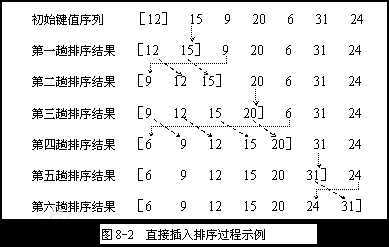标签:style blog http color os io ar strong for
本文主要说明插入排序、shell排序两种排序方法。
一、插入排序
算法思想:
假定这个数组的序是排好的,然后从头往后,如果有数比当前外层元素的值大,则将这个数的位置往后挪,直到当前外层元素的值大于或等于它前面的位置为止.这具算法在排完前k个数之后,可以保证a[1…k]是局部有序的,保证了插入过程的正确性.
插入排序过程示例:
下面是对无序表[12,15,9,20,6,31,24]的排序过程:

伪代码:
INSERTION-SORT(A)
1 for j ← 2 to length[A]
2 do key ← A[j]
3 ? Insert A[j] into the sorted sequence A[1 ‥ j - 1].
4 i ← j - 1
5 while i > 0 and A[i] > key
6 do A[i + 1] ← A[i]
7 i ← i - 1
8 A[i + 1] ← key
代码实现:
static int count = 0;
/***
* 把n个待排序的元素看成一个有序表和一个无序表, 开始有序表只包含一个元素,无序表中包含n-1个元素,
* 排序过程中每次从无序表中取出第一个元素,把它的排序码依次与有序表元素的排序码进行比较, 将它插入到有序表中的适当位置,使之成为新的有序表。
*/
public static void runInsertSort(int[] a) {
for (int i = 1; i < a.length; i++) {
int insertVal = a[i];
// insertValue准备和前一个数比较
int index = i - 1;
while (index >= 0 && insertVal < a[index]) {
// 将把a[index]向后移动
a[index + 1] = a[index];
// 让index向前移动一位
index--;
}
// 将insertValue插入到适当位置
a[index + 1] = insertVal;
System.out.println("indexPos>>>"+(index+1));
System.out.print("第" + (i) + "次排序结果:");
for (int k = 0; k < a.length; k++) {
System.out.print(a[k] + "\t");
}
System.out.println("");
count++;
}
System.out.print("最终排序结果:");
for (int l = 0; l < a.length; l++) {
System.out.print(a[l] + "\t");
}
}
public static void main(String[] args) {
int[] array = new int[6];
for (int k = 0; k < array.length; k++) {
array[k] = (int) (Math.random() * 100);
}
System.out.print("排序之前结果为:");
for (int i = 0; i < array.length; i++) {
System.out.print(array[i] + "\t");
}
System.out.println("");
runInsertSort(array);
System.out.println("交换次数:"+count);
}
打印结果如下:
排序之前结果为:66 12 90 75 43 85
indexPos>>>0
第1次排序结果:12 66 90 75 43 85
indexPos>>>2
第2次排序结果:12 66 90 75 43 85
indexPos>>>2
第3次排序结果:12 66 75 90 43 85
indexPos>>>1
第4次排序结果:12 43 66 75 90 85
indexPos>>>4
第5次排序结果:12 43 66 75 85 90
最终排序结果:12 43 66 75 85 90 排序次数:5
二分插入排序
插入排序中,总是先寻找插入位置,然后在实行挪动和插入过程;寻找插入位置采用顺序查找的方式(从前向后或者从后向前),既然需要插入的数组已经是有序的,那么可以采用二分查找方法来寻找插入位置,提高算法效率,但算法的时间复杂度仍为O(n2)。
public class SortSolution {
static int count = 0;
/***
* 向有序序列中插入元素,那么插入位置可以不断地平分有序序列, 并把待插入的元素的关键字与平分有序序列的关键字比较,以确定下一步要平分的子序列,
* 直到找到合适的插入位置位置。
*/
public static void runBinaryInsertSort(int[] a) {
for (int i = 1; i < a.length; i++) {
int insertVal = a[i];// 待插入的值
int low = 0;
int high = i - 1;
while (low <= high) {
// 找出low,high的中间索引
int mid = (low + high) / 2;
// 如果要插入的值大于mid的值
if (insertVal > a[mid]) {
low = mid + 1;
}// 限制在索引大于mid的那一半中搜索
else {
high = mid - 1;
}// 限制在索引小于mid的那一半中搜索
}
// 将low到i处的所有元素向后整体移动一位
for (int j = i; j > low; j--) {
a[j] = a[j - 1];
}
// 将insertValue插入到适当位置
a[low] = insertVal;
System.out.println("indexPos>>>"+(low));
//System.out.print("\n");
System.out.print("第" + (i) + "次排序结果:");
for (int k = 0; k < a.length; k++) {
System.out.print(a[k] + "\t");
}
System.out.println("");
count++;
}
}
public static void main(String[] args) {
int[] array = new int[1500];
for (int k = 0; k < array.length; k++) {
array[k] = (int) (Math.random() * 100);
}
SimpleDateFormat df = new SimpleDateFormat("yyyy-MM-dd HH:mm:ss");
Date begintime = new Date();
System.out.println("开始时间: " + df.format(begintime));
System.gc();
System.out.print("排序之前结果为:");
for (int i = 0; i < array.length; i++) {
System.out.print(array[i] + "\t");
}
System.out.println("");
runBinaryInsertSort(array);
System.out.println("交换次数:"+count);
Date endtime = new Date();
System.out.println("结束时间:" + df.format(endtime));
Date time = new Date(endtime.getTime() - begintime.getTime());
System.out.println("总用时间:" + time.getMinutes() + "分"
+ time.getSeconds() + "秒");
}
}
标签:style blog http color os io ar strong for
原文地址:http://www.cnblogs.com/ITtangtang/p/3959960.html